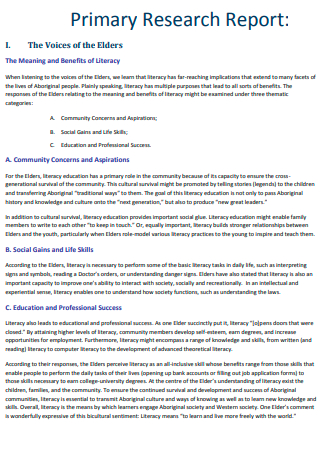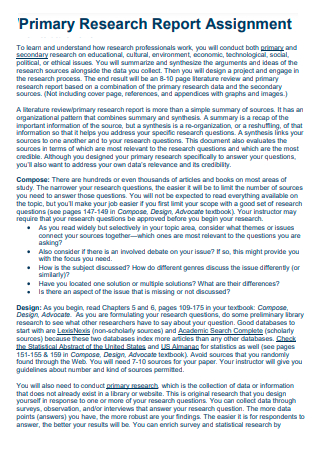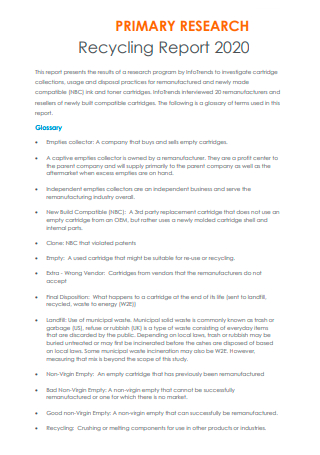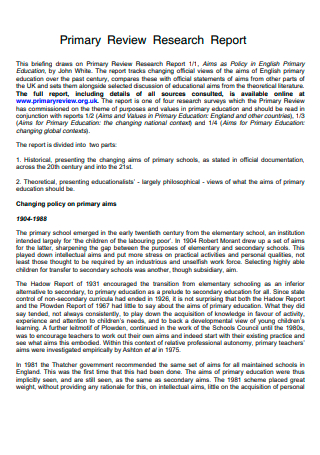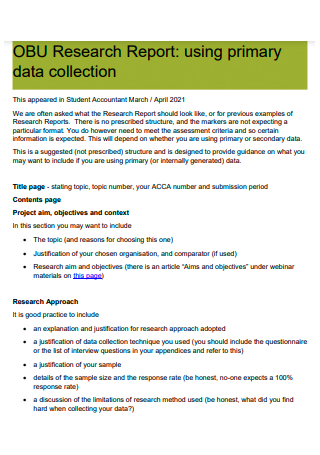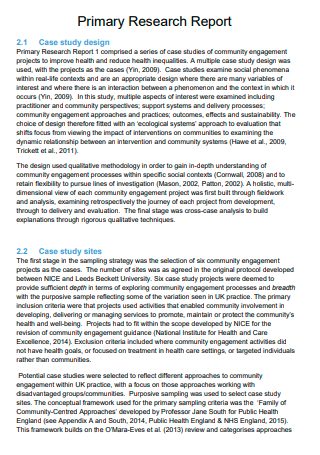5+ Sample Primary Research Report
FREE Primary Research Report s to Download
5+ Sample Primary Research Report
What is a Primary Research Report?
Different Types of Primary Research Report
Basic Elements of an Primary Research Report
How to Write a Primary Research Report
FAQs
What are some examples of primary research reports?
What is the purpose of a primary research report?
What are the significant steps in writing a primary research report?
How to synthesize research findings?
What is a Primary Research Report?
A primary research report is a clear and comprehensive document that demonstrates the original information directly and it contains context-specific data that can solve a specific issue or situation. This is a beneficial tool that allows researchers to carefully study, analyze, and present first-hand information, showcasing its authenticity and validity in the research management or institution.
One example of a primary research report is a market research report. According to a reference, the market research industry in the U.S. has undergone a solid growth over the five years, being 45% in the global market research revenue in 2018. Thus, all types of research professionals such as market researchers, educational researchers, business researchers, medical researchers, biological science researchers, and many others should record and examine their primary research process while creating a clear and systematic primary research report.
Different Types of Primary Research Report
The book Primary Research and Writing: People, Places, and Spaces stated that many students are having difficulties and often confused about primary research practices. In this section, we will help you to increase your knowledge and research skills while learning and understanding the common types of primary research reports because your technique of writing is determined by the type of primary research report you will write. Read the following details below:
1. Educational Primary Research Report
Educational primary research reports are essential to further the knowledge and understanding of educators, school administrators, supervisors, and teachers about their teaching practice, the challenges of implementing educational policies, the improvement of educational organizations, and other critical factors affecting school practices. So, teaching professionals need to be keenly aware that improving practice in their classroom is a high priority for them and their respective schools. It is important that they are able to reach all of their students in a meaningful way so that they can improve the outcomes that they observe them achieve on state and district assessments and their daily lives. Designing a research study will help teachers to understand how their practice impacts the students in their school.
For example, a research problem is about the needs of English-language learner students and the study examines how leaders can create systems of support for classroom teachers who work with linguistically diverse students. There are vast considerations when it comes to designing a research study. So, you need to consider the research paradigm that you will adopt, as well as the ontology and epistemology that underpin this paradigm. Consider who you will include in your primary research and where your study will take place. Then, carry out your study and analyze your data. Thus, developing an effective primary research report in education is important to determine and evaluate one’s teaching quality especially in digital or virtual classrooms.
2. Primary Research Report in Business
Conducting primary research in business firms, corporations, and organizations effectively is useful as it answers specific research questions and allows better decision making inside the business. Typically, business researchers utilize three formal communication approaches which are the research proposal, the written research report, and the oral presentation. Also, there are times that more than one presentation or primary research report may be required. These different mechanisms bring opportunities to help the business project become valuable. When writing business research documents and reports, business research report writers should remember that the main purpose of a primary research report is not to entertain or give a lasting impression to the readers with literary eloquence but to guide in decision making.
Who is the audience for the primary research report? Where is the organization now? What is the objective of the primary research report? How do you propose to fulfill the objectives? These are the critical points that must be addressed during the process of creating a clear and effective primary research report. In this way, managers and other key individuals in the business can easily identify the essential information in a primary research report. Forget the complicated and thick research reports as you move forward in developing simple business research reports.
3. Marketing Primary Research Summary Report
Which is the best eco-friendly and versatile bag in the market? What flavored yogurt drink gives the most satisfaction? Performing a primary research in marketing is essential to enable business firms in reassessing their goals on the basis of new opportunities, in confirming the target segment and creating a beneficial message for the segment. Marketing researchers should obtain and utilize surveys, observations and experiments with the help of questionnaires, checklists and plans so that they are able to complete the advertising surveys and create well-detailed research reports.
Through marketing primary research, it confirms the strong views held by business firms and makes the researchers aware of the consumer’s behavior towards competitive products. Additionally, it elevates the effectiveness and efficiency of the marketing and advertising campaign. To be successful in writing a marketing primary research summary report, marketing researchers should set up the goals for the research, search the sources of secondary information, analyze secondary data, plan samples for primary research, collect data, and analyze the data.
4. Primary Research Report in Behavioral Science
The primary research report in behavioral science exists to inform several people about what scientists have learned and understood in the course of their research. It starts by identifying the research question and explaining the rationale for the investigation. It continues with a clear description of how the question was investigated so that readers can examine the validity of the research and of the knowledge that it produced. After that, the results of the investigation are demonstrated: the data that provide a basis for answering the question. The primary research report concluded with a discussion of the meaning of the data or simply, the answers they provide to the research questions.
Behavioral scientists also use observation, interviews, surveys and experiments in order to develop and test theories that explain when and why individuals behave as they do. Anthropology, psychology and sociology are the academic disciplines under behavioral sciences. Their primary research work has an explicit focus on the understanding of behavioral or social processes, as well as using the processes to predict or influence health outcomes or health risk factors. Creating an in-depth primary research report in behavioral science is important to guide in predicting, preventing and managing different kinds of illnesses in individuals and in whole populations.
5. Primary PE and Sport Premium Survey Research Report
Several school headteachers and senior managers in primary schools also need to conduct surveys in order to examine how the PE and sports premium is being utilized in schools in some countries and the possible impacts of the fund on PE and sports provision. For example, a primary research study reported that there were changes by more than two thirds of schools including 76% in buying new equipment, 74% in providing more extra-curricular activities, and 67% in employing a new sports coach.
Basic Elements of an Primary Research Report
In this section, you will learn how to construct a remarkably written and well-detailed primary research report. However, a primary research report has different features. Include the following elements for you to create an impressive document:
How to Write a Primary Research Report
Developing a primary research report is a worthwhile method to help various researchers in navigating and documenting the primary research process. Thus, students need to learn how to choose topics that appeal to them, follow a list of steps and suggestions to look for archives, visit collections, explore ways to analyze findings and introduce the results. A primary research report can effectively outline one’s evidence concerning the use of diverse methods in their research practice. Below are some easy-to-follow tips that indicate how to design and write a professional primary research report:
Step 1: State the Primary Goals in the Research
What are your primary research goals? First, you need to state the primary goals in the research study that you will be performing. Define the purpose of your research or simply, know exactly the specific matter you have set out to achieve. This is helpful for you to monitor and evaluate your progress in your primary research work.
Step 2: Outline the Primary Research Process
Outline the overall primary research process that you will be adopting throughout your primary research study. Describe how you went on collecting your primary research data. Who were the research participants? What materials did you use? When did you collect the data? Where did you collect the data? How did you collect the data? Answer these questions accurately yet concisely without the repetition of information. To efficiently write this section, divide it into four subsections: overview or design, participants or subjects, materials or apparatus, and procedure. Keep in mind that the overview and materials subsections are optional while the remaining ones are required.
Step 3: Illustrate the Results of the Primary Research
As you illustrate the results of your primary research, move from the general to specific, showing main effects before interactions and the overall scores or percentages. Organize your main results of the research work in various ways such as hypothesis, independent variable, or dependent variable. Use some headings to clearly present the results of your primary research study. At the last part of each subsection, briefly summarize your findings and provide a transition to the next subsection. Thus, tell your reader what you discovered in your primary research.
Step 4: Proofread and Revise the Research Report
Review your overall primary research report and check if you fully include all the crucial elements in your report. If you notice that you overlook some sections that require sufficient points, we recommend that you edit and revise the document thoroughly.
Step 5: Prepare the Final Primary Research Report
After the proofreading and revision process, you can now prepare the final primary research report. Add some notes and other messages you want to inform the management on the concluding part of your document. Skim your primary research report for final evaluation and quality check.
FAQs
What are some examples of primary research reports?
Some examples of action research reports are primary research report assignment, primary research recycling report, primary review research report, primary data collection research report, and more.
What is the purpose of a primary research report?
The purpose of a primary research report is to demonstrate the results of the overall primary research process. It is beneficial in supplementing a particular research in secondary sources such as books, journals, or magazines. It can be used when the researchers focus on their research writing projects. Plus, it can be applied in a variety of settings like academic, business and personal.
What are the significant steps in writing a primary research report?
When you write your primary research report, you should perform the crucial steps such as stating the primary goals in the research, outlining the primary research process, illustrating the results of the primary research, proofreading and revising the research report, and preparing the final primary research report.
How to synthesize research findings?
Synthesizing research findings means combining the information in a relevant way. In order to synthesize your research findings, summarize the information, examine it, interpret it, and draw conclusions for your readers.
Writing a simple and effective primary research report is integral in documenting fundamental information in a research study and in providing innovative solutions to the research problems and other issues of concern. To be successful in primary research report writing, constantly think about your readers as you think about what they want from you and why. Contemplate on how you want to influence them and how they will react to what you need to say through your report. Take the reader-centered approach when it comes to preparing your primary research report. So, here are some of our downloadable and printable primary research report samples available in different kinds of formats. Simply click our sample primary research reports in this article and start downloading now!

